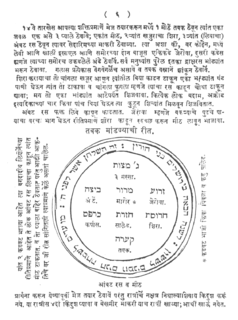 W
WMarathi is an Indo-Aryan language spoken predominantly by Marathi people of Maharashtra, India. It is the official language and co-official language in the Maharashtra and Goa states of Western India, respectively, and is one of the 22 scheduled languages of India. With 83 million speakers as of 2011, Marathi ranks 10th in the list of languages with most native speakers in the world. Marathi has the third largest number of native speakers in India, after Hindi and Bengali. The language has some of the oldest literature of all modern Indian languages, dating from around 600 AD. The major dialects of Marathi are Standard Marathi and the Varhadi dialect. Koli, Ahirani Dialect Specially Agri, and Malvani Konkani have been heavily influenced by Marathi varieties.
 W
WAbhanga is a form of devotional poetry sung in praise of the Hindu god Vitthal, also known as Vithoba. The word "abhang" comes from a for "non-" and bhang for "ending" or "interrupting", in other words, a flawless, continuous process, in this case referring to a poem. By contrast, the devotional songs known as Bhajans focus on the inward journey. Abhangs are more exuberant expressions of the communitarian experience. Abhanga is considered a form of the ovi. Abhangs are sung during pilgrimage to the temples of Pandharpur, by the devotees.
 W
WJudeo-Marathi is a form of Marathi spoken by the Bene Israel, a Jewish ethnic group that developed a unique identity in India. Judæo-Marathi is, like other Marathi, written in the Devanagari script. It may not be sufficiently different from Marathi as to constitute a distinct language, although it is characterized by a number of loanwords from Hebrew and Aramaic as a result of influence from the Cochin Jewish community, Judæo-Malayalam and Portuguese and also some influence from the Urdu language. It has some linguistic features in common with various Jewish languages, developed by Jewish communities in widely disparate places in times, which are also variants of a local language with loanwords from Hebrew and Aramaic.
 W
WMaharashtri Konkani, or Konkan Marathi, is a group of Konkanic dialects spoken in the Konkan region. George Abraham Grierson, a British linguist of the colonial era referred to these dialects as the Konkan Standard of Marathi in order to differentiate it inside the Konkani language group.
 W
WThe Ministry of Marathi Language is a ministry in government of Maharashtra. Ministry is responsible for promotion of Marathi language in India as well as abroad. Language department offers free Marathi classes to non-Marathi speakers living in Maharashtra.
 W
WModi is a script used to write the Marathi language, which is the primary language spoken in the state of Maharashtra, India. There are multiple theories concerning its origin. The Modi script was used alongside the Devanagari script to write Marathi until the 20th century when the Balbodh style of the Devanagari script was promoted as the standard writing system for Marathi.
 W
WMarathi theatre is theatre in the Marathi language, mostly originating or based in the state of Maharashtra in India, and elsewhere with Marathi diaspora. Starting in the middle of the 19th century, it flourished in the 1950s and 1960s, and includes forms like Sangeet Natak and Tamasha. Today, it continues to have a marked presence in the State of Maharashtra with a loyal audience base, when most theatre in other parts of India have had tough time facing the onslaught of cinema and television. Its repertoire ranges from humorous social plays, farces, historical plays, musical, to experimental plays and serious drama of the 1970s onwards, by Vijay Tendulkar, P. L. Deshpande, Mahesh Elkunchwar and Satish Alekar, which have influenced theatre throughout India. In the post-independence era, Bengali theatre, and Marathi theatre have been at the forefront of innovations and significant dramaturgy in Indian theatre.